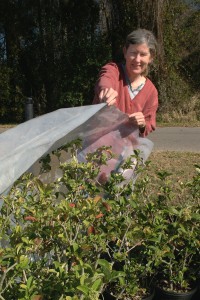North Florida’s gardeners are facing a new set of challenges dealing with the effects of cold weather. However, a little planning and creativity can make plant protection in the landscape a relatively simple process.
Many homeowners and landscape managers want to know when plants will need protection. The point of freezing is a good rule of thumb for most temperate zone plants.
It is worth noting there is a difference in the terms used for cold weather conditions. Frost, freeze and hard freeze all describe different circumstances.
- Frost is when water vapour freezes on surfaces. It usually happens on clear nights with still air and can happen when reported air temperatures are above freezing.
- Freezing is when cold air moves in and causes temperatures to drop below 32 degrees Fahrenheit. This condition commonly involves low humidity and wind, making drying out a big problem for plants.
- A hard freeze is when temperatures dip below 28 degrees Fahrenheit. Some tropical plants will survive a few degrees below freezing for very short periods, but extended periods of freezing or heavy frost may require lights or other heat used safely in combination with covering the plant.
Some plants can be moved indoors for the holidays and incorporated into the interior décor, rather than cramming them last-minute into a chaotic bundle when a freeze looms.
Get prepared by identifying old sheets, blankets and drop cloths which can be used as covers for tender or tropical zone plants which must remain outside. Test potential covers beforehand to assure all plants will be thoroughly covered.
It is best if the covers enclose the plant entirely without crushing it. Heavy blankets are great insulation, but only a good idea on the sturdiest of plants.
A tomato cage or other support structure can be used to keep the weight off the plant. Covers also need to be secured at the ground with pins or weights to assure cold air does not enter from below and collect under the cover.
Finally, keep storage bins handy and remove the covers in the daytime if temperatures are above 55 degrees Fahrenheit.
Monitor weather reports and react accordingly so tender and tropical plants see spring 2016.
- Get Your Trees Ready For The Winds of October - October 8, 2019
- Feeding Caterpillars Aren’t Always Cute - August 10, 2018
- Wild Azaleas - May 23, 2018

